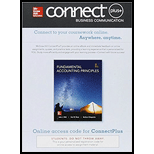
Introduction:
Margin of Safety is calculated by subtracting Break- even Sales from the Actual Sales of a concern. It depicts the excess of Total Sales from the Break- even Point. It is the Net Revenue earned after paying for all the Fixed and Variable Costs of the concern.
Break- even point is calculated by dividing Total Fixed Costs incurred by Contribution Margin per unit of the product. It is a point where Total Revenue equals the Total Costs of the concern. In simple terms, it is the point where there is no profit or loss. After this point, Revenue begins to exceed the Costs incurred.
Contribution Margin is the excess between Selling Price and Total Variable Costs associated with the product. It is that proportion of Revenue which is left after deduction of Total Variable Costs.
To determine:
Margin of Safety (a) in dollars and (b) as a percent of expected sales of Zhao Co.
Want to see the full answer?
Check out a sample textbook solution
Chapter 21 Solutions
Connect 2-Semester Access Card for Fundamental Accounting Principles
- answer?arrow_forwardneed help this questionarrow_forwardStriveTech Co. uses the high-low method to analyze cost behavior. The company observed that at 18,000 machine hours of activity, total maintenance costs averaged $28.00 per hour. When activity increased to 22,000 machine hours (still within the relevant range), the average total cost per machine hour dropped to $25.00. Based on this information, the fixed cost was: a. $396,000 b. $297,000 c. $308,000 d. $220,000 e. $528,000 helparrow_forward
- 4 POINTSarrow_forwardMona reported $70,000 in net profit for the year using absorption costing. The company had no units in beginning inventory, planned and actual production was 21,500 units and sales were 19,000 units during the year. Variable manufacturing costs were $20 per unit and total budgeted fixed manufacturing overhead was $100,000. There was no underapplied or overapplied overhead reported during the year. Determine the net profit under variable costing.arrow_forwardPlease give me true answer this financial accounting questionarrow_forward
- Can you help me with accounting questionsarrow_forwardSolve this Accounting problemarrow_forwardDover Chemical Company manufactures specialty chemicals by a series of three processes, all materials being introduced in the Distilling Department. From the Distilling Department, the materials pass through the Reaction and Filling departments, emerging as finished chemicals. The balance in the account Work in Process—Filling was as follows on January 1: Work in Process—Filling Department(2,700 units, 30% completed): Line Item Description Amount Direct materials (2,700 × $15.80) $42,660 Conversion (2,700 × 30% × $10.30) 8,343 Total $51,003 The following costs were charged to Work in Process—Filling during January: Direct materials transferred from Reaction Line Item Description Amount Department: 34,800 units at $15.60 a unit $542,880 Direct labor 198,580 Factory overhead 190,793 During January, 34,500 units of specialty chemicals were completed. Work in Process—Filling Department on January 31 was 3,000 units, 90% completed.arrow_forward

 AccountingAccountingISBN:9781337272094Author:WARREN, Carl S., Reeve, James M., Duchac, Jonathan E.Publisher:Cengage Learning,
AccountingAccountingISBN:9781337272094Author:WARREN, Carl S., Reeve, James M., Duchac, Jonathan E.Publisher:Cengage Learning, Accounting Information SystemsAccountingISBN:9781337619202Author:Hall, James A.Publisher:Cengage Learning,
Accounting Information SystemsAccountingISBN:9781337619202Author:Hall, James A.Publisher:Cengage Learning, Horngren's Cost Accounting: A Managerial Emphasis...AccountingISBN:9780134475585Author:Srikant M. Datar, Madhav V. RajanPublisher:PEARSON
Horngren's Cost Accounting: A Managerial Emphasis...AccountingISBN:9780134475585Author:Srikant M. Datar, Madhav V. RajanPublisher:PEARSON Intermediate AccountingAccountingISBN:9781259722660Author:J. David Spiceland, Mark W. Nelson, Wayne M ThomasPublisher:McGraw-Hill Education
Intermediate AccountingAccountingISBN:9781259722660Author:J. David Spiceland, Mark W. Nelson, Wayne M ThomasPublisher:McGraw-Hill Education Financial and Managerial AccountingAccountingISBN:9781259726705Author:John J Wild, Ken W. Shaw, Barbara Chiappetta Fundamental Accounting PrinciplesPublisher:McGraw-Hill Education
Financial and Managerial AccountingAccountingISBN:9781259726705Author:John J Wild, Ken W. Shaw, Barbara Chiappetta Fundamental Accounting PrinciplesPublisher:McGraw-Hill Education





